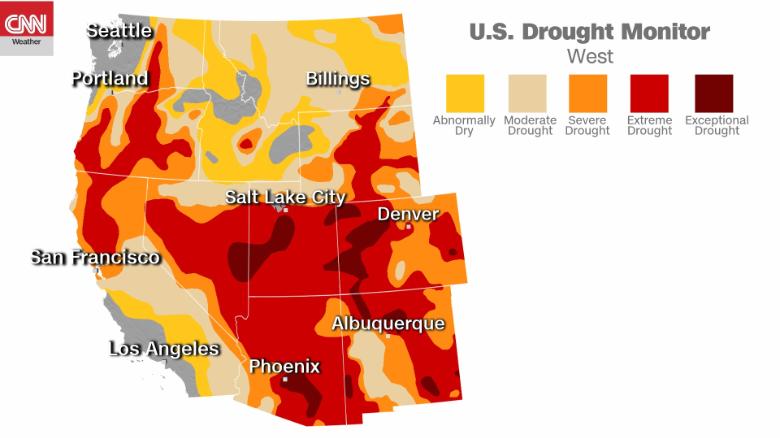Scorching. Blistering. Burning. There are only so many ways to describe how hot it’s been in the West this year.
The desert Southwest is a hot place to live, but imagine spending over half of the year with high temperatures of at least 100 degrees. Parts of California and Arizona did just that this year.
Long stretches of heat don’t just adversely impact humans and animals, but also contribute to the ongoing drought and wildfires in the western US.
A series of high-pressure systems in unfavorable locations have not only allowed for temperatures to soar over the past few months, but have effectively blocked any large, rainmaking storms from moving through the area.
“High pressure directly overhead, or to the south of Arizona contributed to our lack of rainfall and hot temperatures,” said Emily Carpenter, a meteorologist for the National Weather Service’s office in Tucson, Arizona.
It’s more than just a little dry. The month of September tied the previous record set in 1953 for the driest month in Tucson. In both years, no rainfall was measured.
“The area of high pressure aloft that drives the annual monsoon flow remained right over the top of Arizona or to the south for a large part of summer which suppressed thunderstorms, kept deep monsoonal moisture to our south and led to the very hot temperatures that resulted in the hottest and 2nd driest monsoon on record,” John Glueck, a senior meteorologist weather service, said in his compilation of data of the 2020 monsoon season.
But it’s a ‘dry heat’
The 2020 monsoon season ranked as the second driest on record for the Tucson area. The monsoon season is defined by the weather service as any rainfall from June 15 to September 30. The Tucson area only received 1.62 inches of rain in the 2020 monsoon season, second only to 1924 when the area only picked up 1.59 inches.
Other southwestern cities have also felt the drought. Phoenix hasn’t recorded any measurable rain since August 20. In San Diego, June 29 was the last time any measurable rain fell. Downtown Los Angeles probably forgets what rain even looks like, since the city last saw some on May 18.
Las Vegas set a record for the longest dry stretch in its recorded history, currently sitting at 180 consecutive days, including Saturday since no rain is in the forecast. The city last saw measurable rainfall on April 20.
None of these places aren’t alone in the struggle for rainfall. More than 80 percent of the western US is dealing with drought conditions.
In Arizona, Colorado, New Mexico, Nevada and Utah, the level of extreme drought encompasses more than 50% of each state. The weather service defines extreme drought as “an area where major crop and pasture losses are common, fire risk is extreme, and widespread water shortages can be expected requiring restrictions.”
“With over 95% of Colorado experiencing drought conditions and over 50% considered an extreme drought, the state is in desperate need of rain and snow,” says Derek Van Dam, CNN meteorologist. “This state is yet another example of the long-term drying trend experienced over the western US, a product of climate change and our warming planet.”
A very prolonged stretch of heat
And if the drought alone wasn’t bad enough, this summer has brought baking temperatures with many cities experiencing an abnormal amount of 100-degree days.
On Friday, Tucson hit 101 degrees which means the city tied with October 16, 1991, for the latest occurring 100-degree day in the year. This coming after hitting 110 degrees on September 4, the latest the temperature has reached 110, breaking the old record set on August 22, 1930. September 4 also is the city’s hottest September temperature on record.
Friday also added to Tucson’s record total of 108 days with 100-degree temperatures in 2020. For comparison, the average number of 100-degree days in a year for Tucson is 62, according to the weather service.
Palm Springs, California, has also seen a record number of triple-digit days this year. The forecast calls for a high temperature of 102 degrees on Saturday, which will mark the 148th day of temperatures at or above 100 in Palm Springs.
On Friday, Phoenix had its 145th day in 2020 where the thermometer reached at least 100 degrees — a record according to the weather service’s Phoenix office. The previous record of 143 days was set in 1989.
As of Saturday, exactly half of the days this year — 145 days out of 290 — have reached 100 degrees in Phoenix .
This means that both Palm Springs and Phoenix have spent at least half of the 290 days so far of this year with temperatures at or above 100 degrees. An achievement that neither probably want to have.
Unfortunately, things don’t look like they will change all that much over the next few months. The National Oceanic and Atmospheric Administration’s official winter outlook calls for more additional warmer, drier conditions across the Southwest thanks in part to a very strong La Nina.
>>>details


